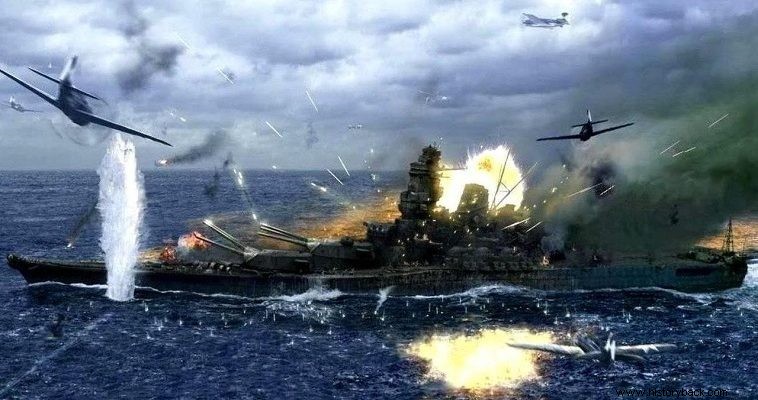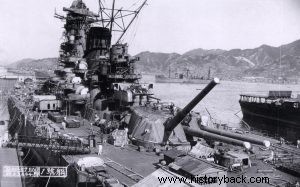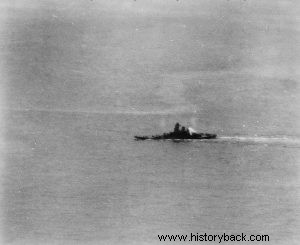
The battleship Yamato was, along with its brother Musashi, the most powerful battleship ever to sail the seas of Earth. In 1945 the strategic situation for Japan was grim. Defeats followed defeats and the Allies advanced. The once mighty Imperial Japanese Navy was a shadow of its former self.
The Japanese had drawn up the "Victory" defense plan, but the plans could hardly be implemented, despite their fanaticism, against the overwhelming material superiority of the Allies and especially the Americans. On April 1, the Americans landed on Okinawa. The Japanese threw their weight into the battle, including hundreds of kamikaze.
However, it was decided that the last Japanese warships would participate in the battle, especially the battleship Yamato, which would be the biggest kamikaze. The vessel would sail in the waters off Okinawa, submerge itself in the shallows, and be a formidable support to the Japanese defenses, after the battleship first engaged the American ships. The vessel would continue to fight as a "floating" gunnery until it was destroyed. . Then the survivors of his crew would fight as infantry on the island.
Yamato and her escort vessels sailed from Japan on 6 April, under Rear Admiral Seiichi Ito. The Yamato was escorted by the light cruiser Yahagi and eight destroyers. It is worth noting that the last fuel reserves were allocated to the Yamato squadron. The ships' crews were informed of the suicide operation and anyone who did not wish to was allowed to opt out. No one refused.
Sail towards fate
The Japanese ships were spotted almost immediately after their departure by American submarines which informed the superior echelons. However, the Japanese also knew that I had been spotted as they intercepted the signals of the American submarines. At dawn on April 7th the Japanese ships, sailing at 20 knots in defensive formation, were sailing towards Okinawa . However, one of the destroyers suffered a mechanical failure and turned back. In the meantime the Yamato flotilla was now closely watched by American reconnaissance aircraft.
At 10.00 Rear Admiral Ito ordered a turn to the west, wanting to make the Americans believe he was turning back . At 11.30, however, the Japanese ships were spotted again by American jets, which saw them turning again towards Okinawa and informed about it.
Immediately the commander of the 5th Fleet Admiral Spruance ordered Task Force 54, under Rear Admiral Dayo, to attack and destroy the Japanese ships. Eventually, however, the aircraft carriers of Task Force 58 (Vice Admiral Mitcher) were ordered to take over the mission. In a few hundred American aircraft took off from eight aircraft carriers, which were supported by 30 destroyers, 11 cruisers and six battleships.
From the air of Armageddon
Around 12:00 the first wave of American aircraft was over the Japanese ships. It consisted of F6F Hellcat and F4U Corsair fighters tasked with countering Japanese aircraft that the Americans assumed would be covering enemy shipping. But the Japanese ships had no air cover, so the American vertical bombers and torpedo planes followed fearlessly. The Japanese ships opened fire on them.
The Yamato even put in its beastly 18.1 inch guns. The Japanese squadron increased its speed to 24 knots. But the American planes attacked. First the chasers attacked with machine guns and some with rockets. This was followed by the SB2C Helldiver vertical bombers and the TBM Avenger torpedo planes.
At 12.46 one torpedo critically hit the cruiser Yahagi. The engine room was destroyed and the vessel immobilized making it an easy target. In a little while another six torpedoes and at least 12 bombs hit it and literally tore it to pieces. The destroyer Isokaze that rushed to the cruiser's aid was also blown apart, literally. Yahagi at 14.05 capsized and sank.
Yamato too was hit by two bombs and a torpedo. Also the destroyers Hamakaze and Suzutsuki were seriously damaged and put out of action on fire.
The third wave
Between 13.20 and 14.15 the second and third waves of American aircraft appeared and immediately began their attacks. Their target was the Yamato which was hit by at least eight torpedoes and 15 bombs. The hits caused extensive damage to the vessel and knocked out the firing guides.
Now the Japanese gunners aimed and aimed with only the aid of their eyes. As a result of the torpedo hits, the battleship heeled over and to prevent it from capsizing, it was ordered to flood the starboard forward compartments. This resulted in the death sentence of all the crew members who were in them and were not notified to get out. .
Already the speed of the battleship had dropped to 10 knots. At the same time another 110 American planes attacked. Three more torpedoes hit the boat causing heavy damage. New attacks resulted in the destruction of the ship's rudder. It was the end. Ito ordered the ship to be abandoned.
The Yamato was now immobilized, a flaming, yet still, corpse. Ito, as well as the skipper Captain Aruga, however, refused to leave the boat. At 14.20 the boat overturned and three minutes later it blew up. The plume from the explosion reached a height of 6,100 m and was visible from a distance of 200 km. American aircraft were also hit and crashed by the hot pieces of Yamato metal.
At the same time, the destroyer Asashimo was also sinking. The destroyer Kasumi also suffered the same fate. The Suzutsuki, albeit with a severed bow, managed to return. The other three destroyers managed to rescue about 800 men out of the more than 4,200 men aboard the squadron.
The Americans lost only 10 of the 386 aircraft they shot down in the attack. They also lost 12 men. Japanese survivors reported being shelled at sea by US aircraft. However, according to other accounts, the Americans did not attack the Japanese destroyers that were rescuing survivors.
Yamato:Technical Characteristics
Length:263 m
Bidth:38.9 m
Full displacement:71,659 tons
Maximum speed:27 knots
Radius:13,000 km at a speed of 16 knots
Crew:3,000+ men
Armament (1945):9 18.1 inch (406mm) guns
6 155mm guns
24 127mm guns
165 25mm anti-aircraft guns.
4 13.2mm machine guns. .5 mm.
Main gun turrets, maximum thickness 650 mm.

Yamato in final phase of construction. The formidable 18.1-inch guns can be seen.

American auxiliary aircraft carrier Gambier Bay is blown to pieces by Yamato's guns.

Yamato's Last Battle. Artistic illustration.

The Yamato is sailing at maximum speed.

Yamato is hit by a bomb.

The Yamato has been hit and with its bow half-submerged is on fire.

The Yamato blows up.
BEWARE HARD IMAGES
